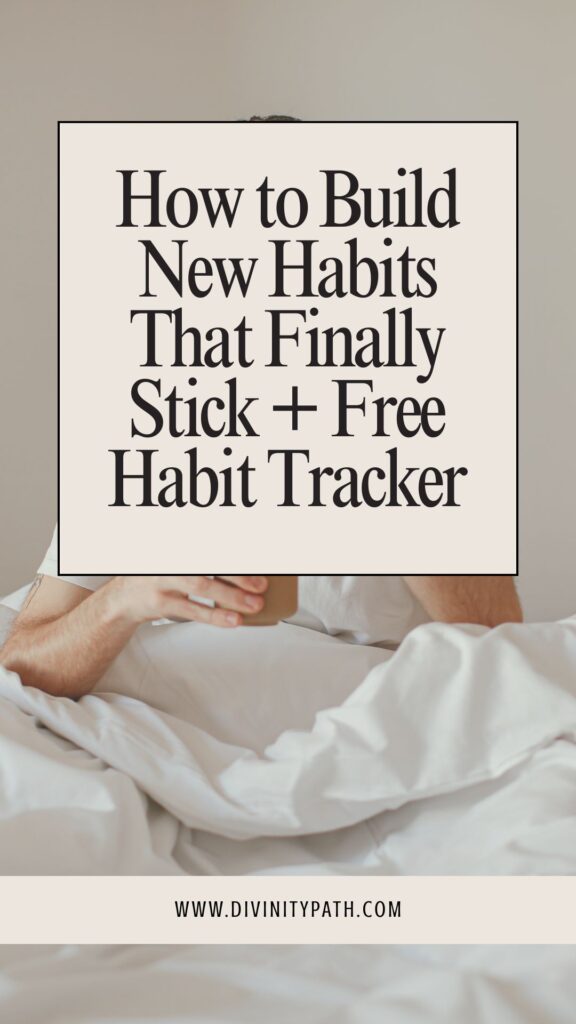How to Build New Habits That Finally Stick + Free Habit Tracker
Let’s be honest – starting a new habit isn’t the hard part. Inspiration strikes, maybe from a motivational video or a quote on Instagram, and the first few days go smoothly. But then… life happens. You skip a day. Then another. And suddenly, you’re right back where you started.
That’s the real struggle, isn’t it? We don’t just want to start. We want to build new, solid habits – the kind that actually stick, quietly shape our days, and bring us closer to where we want to be. Whether it’s regular exercise, morning journaling, or simply drinking more water – we want to move forward, not start over again and again.
Here’s the good news: building lasting habits has nothing to do with being a “strong character” or having “more discipline than others.” It’s about systems. Small steps. Repetition. And yes – a little kindness toward yourself. In this article, we’ll talk all about that – and I’ve also created a free habit tracker for you to help keep track of your habits (because let’s be real, everything is easier when you have something tangible in front of you).

What Are Habits?
Habits are a kind of automation we all have. They’re those little daily rituals we do almost without thinking — like how we brush our teeth in the morning, switch on the coffee machine, or always check our phone when it buzzes. Sound familiar? Habits are like a quiet force behind our behavior, guiding us without us needing to think about every little action.
What’s interesting is that research suggests around 40% of everything we do in a day actually comes from our habits. That means a large portion of our decisions and actions aren’t made consciously, but come from these automated patterns. And if you can build good, positive habits, you’re basically setting the foundation for a better life — without needing to plan or motivate yourself from scratch every single day.
The Common Mistakes People Make When Building New Habits
Now let’s look at what often goes wrong when people try to start new habits. Maybe you’ve found yourself full of energy and motivation, only for it all to fizzle out pretty quickly. You’re not alone — but it doesn’t have to stay that way.
Setting Goals That Are Too Big Right From the Start
One big mistake is wanting too much, too soon. “Starting tomorrow, I’ll work out for at least one hour every day!” — super ambitious, but this kind of expectation quickly leads to burnout and disappointment. It’s better to start small, like 5 minutes of walking or 10 squats you can easily fit into your day. Once that becomes routine, you can build from there.
Relying Too Much on Willpower
Many people believe that willpower and discipline are key. The truth is, willpower isn’t always available. That’s why it’s smarter to lean on your environment — remove distractions, set reminders, or use a free habit tracker that shows your progress. Habits are easier when you build a system.
Lacking Patience and Expecting Immediate Results
The question “How long does it take to form a habit?” is one of the most common. The truth? There’s no magic number. For some, it’s 21 days, for others, several months. What matters is sticking with it, even if results aren’t visible right away. Change builds slowly and quietly.
Trying to Build Too Many Habits at Once
Sometimes people try to build multiple habits at once — healthy eating, regular workouts, meditation, reading… and end up failing at all of them. It’s much better to focus on one or two habits and really lock them in before moving on.
Forgetting About Rewards and Self-Appreciation
Habits aren’t just about discipline and repetition. It’s also important to acknowledge your progress and reward yourself when you hit milestones. It acts as an extra motivator that supports you for the long haul.
8 Helpful Tips on How to Build Lasting Habits
1. Start Small – Almost Laughably Small – And Do It Every Day
You know that feeling when you think you need to become a “new version” of yourself overnight? Tomorrow I’ll be fit. Tomorrow I’ll be disciplined. Tomorrow I’ll be perfect.
Don’t fall for that trap. That’s not how lasting change happens. If you start too strong, you’ll burn out quickly. And then you’ll feel guilty for not keeping it up.
James Clear says it well in Atomic Habits: “You do not rise to the level of your goals. You fall to the level of your systems.”
In other words – big dreams don’t help without a system to support them. So start with small steps. If you want to read more, start with one page a day. If you want to be more active, do three squats every morning. Yes, just three. That’s enough. What matters is that you start shaping your identity – I am someone who reads. I am someone who exercises. That’s not laziness. That’s smart long-term habit building. And that’s the real answer to how to build lasting habits – with small steps you can easily repeat.
You might also love:
- 11 Free Digital Tools That Will Help You Organize Your Life
- 9 Smart Ways How To Respond To Teasing At School
- 13 Questions That Quietly Reveal Your Hidden Childhood Trauma
2. Track Your Progress – In Your Own Way
There’s no better feeling than that little “✓” when you check off a habit at the end of the day. Not because you need to prove anything, but because you’re building trust in yourself. That’s where tools like a habit tracker or even a simple sheet of paper with the days of the month come in.
But here’s the catch — choose a method that really works for you. If you’re a visual type, draw a grid, hearts, or even a coloring chart where each day gets its own square. If you like to write, jot down each night what you managed to do. This becomes your habit worksheet, your map of change.
I also recommend setting a daily phone reminder with a question like: “What did I do for my habit today?” That little ping brings you back to your goal. And when you see your progress laid out clearly, even on days when motivation is low, something inside you says: “Look how far you’ve come — don’t stop now.”

3. Focus on One Habit, Not a Whole Life Makeover
I know, I know – once we start, we want to do everything at once. Morning routine. Healthy eating. More reading. Less Instagram. Plus some meditation in between. But the truth? Your brain gets overwhelmed. And it burns out. Just like a computer slows down when you open too many tabs at once.
So — one habit at a time. So simple, yet so powerful. Pick one that truly matters to you. Not one you “should do,” but one that calls to you on a deeper level. Maybe you want to start journaling again. Maybe you want to walk more. Maybe you want to start your day without your phone.
And until that one habit becomes automatic — don’t move on. Fun fact: studies show it takes an average of 66 days for a new habit to become automatic.
4. Remove as Many Obstacles as Possible
Have you ever heard of a “tipping point”? That small shift that creates a big impact? Malcolm Gladwell described it as “the moment of critical mass, the threshold, the boiling point.”
In the world of habits, it’s that tiny adjustment that eliminates your excuses. If you want to read every evening, leave the book on your pillow. If you want to drink more water, place your bottle on your desk. If you want to meditate more, have the cushion already laid out.
Here’s the thing: the more you have to think, the more chances your brain has to say, “Eh, not today.” So make life simpler. Creating habits that last a lifetime doesn’t mean forcing yourself — it means building an environment that supports you.
I came across a study where students were given a map with the location of a vaccination center. Without the map, 3% showed up. With the map? 28%. Why? Because they no longer had to think — just go. That’s the power of removing obstacles. Strong.
Keep exploring:
- 10 Strategies How To Remove Bad Karma From Your Life
- 11 Things to Stop Caring About If You Want a Happier Life
- Buddha Teachings on Life That Will Shift Your Perspective
5. Link a New Habit to an Existing One — Fit It into Your Routine Like a Lego Brick
If you’ve ever tried to introduce a new habit “out of thin air,” you know how quickly it can fade. But you know what works almost like magic? Attaching it to something you already do daily — without thinking.
This technique is called habit stacking, a term coined by James Clear. The idea is simple: take an existing habit, like making coffee in the morning, and “stack” a new habit onto it. For example, while your coffee is brewing, do a few stretches. Or after brushing your teeth at night, write one line in a gratitude journal.
It sounds almost too easy — but that’s the beauty of it. When a new habit becomes part of an existing routine, your brain doesn’t resist — because it feels familiar and safe.
So think about it: what habits do you already have? And what new habit could you seamlessly stack onto one of them? Just make sure the new habit is small and light — like slipping into your slippers. That’s how it begins.
6. Get a “Habit Buddy”
It’s no secret: when you make a commitment to someone else, you’re more likely to follow through. Why? Because you don’t want to disappoint them. You don’t want to admit you watched Netflix instead of going for that evening walk you promised to your friend.
Find yourself a habit buddy — a friend, a partner, a colleague. It doesn’t have to be the same activity every day, what matters is that you check in regularly, ask each other how it’s going, and even admit when things get tough. You could also create a shared habit tracker and encourage each other when one of you loses motivation. A little support goes a long way.
7. When You Stumble — Don’t Quit, Just Continue
This might be the hardest part of building habits: when you skip a day. Then another. And suddenly you think, “Ugh, forget it. I failed again.”
But here’s something we all need to learn: stumbling isn’t the end. Habits aren’t a test you fail if you miss a day. They’re a journey. And journeys go up and down. Everyone (really, everyone) has days with no motivation, no energy, no success. What matters is what you do the next day. Get back up. Return. No guilt. Just continue.
James Clear says: Never miss twice in a row. The first miss is a mistake, the second is a choice. And you always have a choice. Every time. Even after three days off, you can start again. And it still counts.
If you like, create a little habit emergency plan ahead of time. What will you do if you miss a day? How will you return? Write a line that lifts you up. Or set a phone reminder that gently says: You are more than one missed day. You know how to come back.

8. Pause and Ask Yourself: Is This Actually Working?
Sometimes we push forward like a bulldozer. We set a goal, make a plan, start a new habit — and just keep going, even when it doesn’t feel right anymore. Why? Because we told ourselves we would do it.
But the truth is… sometimes a habit just isn’t working. Maybe it’s draining you. Maybe it’s not aligned with your current life.
So give yourself permission to pause and ask a few honest questions, like:
- How do I feel during this habit?
- Is this helping me or just stressing me out?
- Is this still in line with my values, desires, and goals?
- Could I reach the same result in an easier, more natural way?
James Clear emphasizes in Atomic Habits that the most effective people aren’t those who never change strategy, but those who quickly notice what’s not working — and dare to adapt. He writes: “You do not rise to the level of your goals. You fall to the level of your systems.”
If the system (your habit) isn’t working, change the system. Not the goal. Not yourself. Just the approach. Maybe evening meditation suits you better than morning. Maybe five minutes of journaling is enough — not thirty. Maybe working out in a group helps more than at home. Every change that’s honestly yours brings you closer to your goal. So don’t be afraid to say: This isn’t working anymore. It’s time to find a new way.









